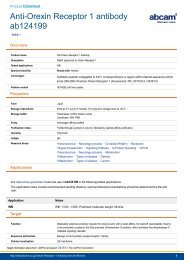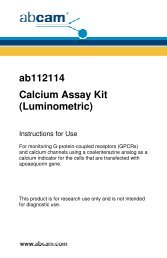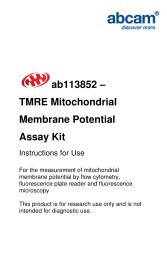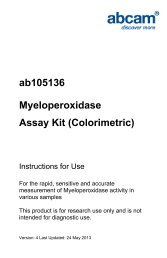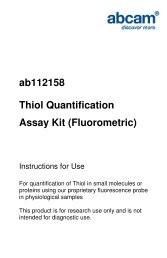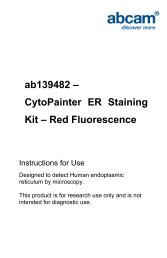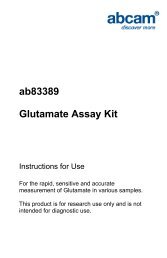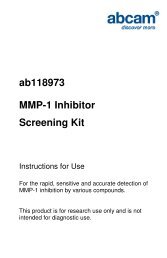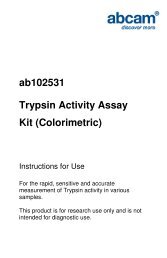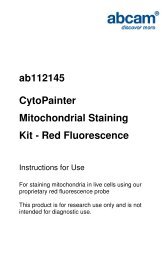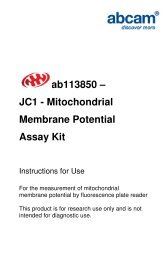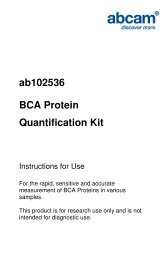Kinase Reaction and Alkylation Protocol - Abcam
Kinase Reaction and Alkylation Protocol - Abcam
Kinase Reaction and Alkylation Protocol - Abcam
Create successful ePaper yourself
Turn your PDF publications into a flip-book with our unique Google optimized e-Paper software.
<strong>Kinase</strong> <strong>Reaction</strong> <strong>and</strong><strong>Alkylation</strong> <strong>Protocol</strong><strong>Protocol</strong> for the treatment of substratesprior to detection by Thiophosphate EsterantibodiesThis product is for research use only <strong>and</strong> is notintended for diagnostic use.
Table of Contents1. Introduction 32. Assay Summary 43. Materials Required 44. <strong>Kinase</strong> <strong>and</strong> <strong>Alkylation</strong> <strong>Protocol</strong> 55. Western Blot <strong>Protocol</strong> 76. Immunoprecipitation <strong>Protocol</strong> 82
1. IntroductionThis novel rabbit monoclonal antibody (RabMAb) can be used todetect kinase substrates containing thiophosphate esters followingthe kinase reaction as described by J. Allen <strong>and</strong> colleagues inNature methods 2007 (Figure 1). This antibody as allow researchersto follow this approach to study kinase-substrate relationships ofinterest. The antibody is also context independent in that it canrecognize serine, threonine, <strong>and</strong> tyrosine thiophosphorylatedresidues in a multitude of kinase phosphorylation consensusmotifs (1).Figure 1. <strong>Reaction</strong> sequence for affinity tagging kinase substrate.References:1. Allen, J.J. et al. Nature Methods, 4(6), 511–516, 20073
2. Assay Summary<strong>Kinase</strong> <strong>Reaction</strong><strong>Alkylation</strong> of ProteinReady to use in Immunoprecipitation or Western Blot.3. Materials Required• ATP-gamma-S (ab138911)• p-nitrobenzyl mesylate (ab138910)• Pipettors <strong>and</strong> pipette tips of various sizes• DMSO• Vortex/ rotator4
4. <strong>Kinase</strong> <strong>and</strong> <strong>Alkylation</strong> <strong>Protocol</strong>1. Perform the kinase reaction substituting ATP-gamma-S in placeof ATP (for more details, refer to supplementary methods sectionof reference 1). Include a control that has PNBM but nonucleotide.Note 1: Avoid using more than 0.5 mM thiol containing additives(e.g. DTT) in the kinase reaction buffer, as it will react with <strong>and</strong>consume the PNBM alkylating reagent. If it is necessary toinclude greater than 0.5 mM thiol additives to the kinasereaction, proteins can be alkylated with 5 mM PNBM in 5%DMSO (by preparing a 100 mM DMSO stock).Note 2: The timing of the reaction can be controlled byquenching by adding EDTA at twice the concentration of metalion. For example, if there is 10 mM MgCl 2 in the assay bufferthen quench with 20 mM EDTA.Note 3: A majority of kinases can utilize ATP-gamma-S as aphosphodonor. If there is a concern that a particular kinase maynot utilize ATP-gamma-S, this can be checked by performingst<strong>and</strong>ard radioactive assays using ATPγ 35 S.5
2. To alkylate the proteins, add 1.5 µl of the 50 mM PNBM stockdirectly for every 30 µl kinase reaction (the final concentrationshould be at 2.5 mM PNBM, 5% DMSO).Note 1: Prepare a 50 mM PNBM (12 mg/ml) stock by dissolvingPNBM in DMSO <strong>and</strong> vortexing. One time use DMSO aliquotsmay be stored at -20°C.3. Briefly vortex the samples <strong>and</strong> alkylate for 1-2 hours at roomtemperature.Note 1: For sample volumes 500 µl or greater, alkylate with“end over end” rotation. Alternatively, alkylate for overnight at4ºC.Note 2: Some precipitation may occur during alkylation; this isnormal <strong>and</strong> should not affect the western blot analysis. Ifdesired, crystals may be removed by centrifugation.4. After alkylation, add SDS-PAGE sample buffer to 1Xconcentration.5. Proceed to Western Blot or freeze sample for later use.6
5. Western Blot <strong>Protocol</strong>1. Heat samples to 95-100ºC for 2-5 minutes if desired <strong>and</strong> loadonto a SDS PAGE gel.2. Transfer proteins to nitrocellulose or PVDF.3. Block for 30-60 minutes at room temp with 5% Milk in TBST(TBS with 0.05% Tween-20).4. Add Thiophosphate Ester Specific RabMAb (ab92570) at1:5,000 in 5% Milk with TBST. Incubate at overnight at 4 °C.Note 1: For most effective blocking when using ab92570, 5%Milk is recommended as the blocking reagent. Do not use BSAor any other similar substitutes.5. Wash a minimum of 3 times with TBST.6. Incubate nitrocellulose with 1:10,000 (1:5,000 if stronger signalis desired) dilutions of goat anti-rabbit HRP antibody in 5% Milkin TBST overnight at 4°C or room temperature for 1 hour.7. Wash nitrocellulose a minimum of 3 times of TBST, then rinse inTBS prior to addition of chemiluminesence reagents.7
8. Develop with chemiluminescent detection reagents. Prepare allreagents, working st<strong>and</strong>ards <strong>and</strong> samples as directed in theprevious section.6. Immunoprecipitation <strong>Protocol</strong>Optional: It may be necessary to add 200-500 µl cell lysate to theimmunoprecipitation sample1. Perform kinase reactions <strong>and</strong> alkylate as described above.Note: Perform a control reaction that doesn’t contain eitherthe the kinase of interest or the ATPγS analog, the choice ofcontrol depends on the experiment.2. After alkylation spin the lysate at 14,000G (max speed on abenchtop microcentrifuge) for 5-10 minutes <strong>and</strong> discard anyprecipitate.3. Remove PNBM with a PD-10 size exclusion column usingRIPA (50 mM Tris pH 8, 150 mM NaCl, 1.0% NP-40, 0.1%SDS, <strong>and</strong> complete protease inhibitors as the eluent.8
4. Assay each fraction for protein content with a BradfordAssay. Pool peak protein containing fractions, generallyfractions 7-9. Discard the final protein containing fraction asit may contain PNBM, which inhibits immunoprecipitationwith the clone 51-8R antibody.5. (optional) Preclear each sample with one-tenth volume ofrProt G agarose for one hour at 4ºC. Spin down the beads<strong>and</strong> transfer the supernatant to a fresh tube.6. Take the pooled fractions or the supernatant <strong>and</strong> addThiophosphate Ester Specific RabMAb (IP version)(ab133473) (about 0.5-1 µg antibody per µg kinasesubstrate). Incubate with gentle rocking overnight at 4ºC.7. Add rProt G agarose beads (one tenth volume of 50% beadslurry). Incubate with gentle rocking for one hour at 4ºC.8. Spin down the beads <strong>and</strong> wash 3-5 times with 500 ul RIPAbuffer.9. Elute immunoprecipitated proteins by boiling for 3 minutes in30 µl sample buffer that contains reductant (ex. DTT) <strong>and</strong>analyze the immunoprecipitated proteins by western blotusing Thiophosphate Ester Specific RabMAb (WB version)(ab92570).9
Note on anti-Rabbit IgG secondary: For optimal IP-blot resultwhen working with targets that may be 25 or 50Kda in size, itis recommended to use a secondary antibody whichspecifically detects the non-reduced rabbit IgG (this willeliminate background IgG b<strong>and</strong>s at 25 <strong>and</strong> 50Kda fromshowing up on your blot).10
UK, EU <strong>and</strong> ROWEmail: technical@abcam.comTel: +44 (0)1223 696000www.abcam.comUS, Canada <strong>and</strong> Latin AmericaEmail: us.technical@abcam.comTel: 888-77-ABCAM (22226)www.abcam.comChina <strong>and</strong> Asia PacificEmail: hk.technical@abcam.comTel: 108008523689 ( 中 國 聯 通 )www.abcam.cnJapanEmail: technical@abcam.co.jpTel: +81-(0)3-6231-0940www.abcam.co.jpCopyright © 2012 <strong>Abcam</strong>, All Rights Reserved. The <strong>Abcam</strong> logo is a registered trademark.All information / detail is correct at time of going to print.11



